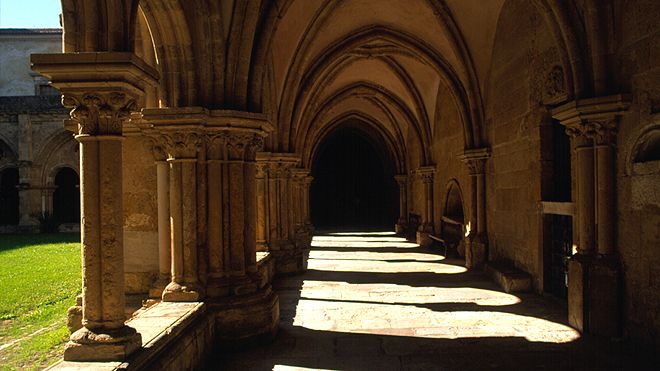Sé Velha de Coimbra

Monuments
Where the second king of Portugal was crowned.
Coimbra (Aeminium, in Roman times) is an Episcopal seat since the 5th century, succeeding neighbouring Conímbriga. Despite its long history, there is no mention of a cathedral until the construction of the Santa Maria de Coimbra Cathedral, which began in 1164 by initiative of Bishop Miguel Salomão. It was consecrated in 1184, despite the rest of the building not yet being finished and in 1185 the second Portuguese king, D. Sancho I, was crowned there. It is the only Portuguese Romanesque cathedral from the time of the Reconquest, which survives relatively intact to this day.
The design of the building is attributed to Master Roberto, of French origin, who directed the construction of the Lisbon Cathedral at the same time and visited Coimbra sporadically. Management of the work was assigned to Master Bernardo, also French, later replaced by Master Soeiro, an architect who later worked on other churches in the diocese of Porto. The building comprises three naves, a slightly protruding transept, a lantern-tower above the cross, and a tripartite sanctuary. Its construction marks a break from the Romanesque cathedrals built until then in the country (Braga and Porto) and the beginning of a new typology called Cathedrals of the South (Coimbra, Lisbon and Évora).
The cloister started being erected in 1218, during the reign of D. Afonso II, being one of the first Gothic works built in Portugal. Larger than normal, it was necessary to destroy a part of the hillside for its construction. It occupies a quadrangular area from the third section of the nave and beyond the perimeter of the sanctuary. It is made up of a vaulted floor and the arcades comprise double pointed arches, set in fine twinned colonnades and with portholes above.
During works in the 16th century some innovations were introduced to the building, including Renaissance doorways, specifically a door known as the Porta Especiosa (Beautiful Door), which is the masterpiece of the architect João de Ruão and the sculptor Nicolau de Chanterenne, inspired by the Italian renaissance.
Inside, it is worth mentioning the Chapel of the Blessed Sacrament, also of João de Ruão, and the Chapel of St. Peter, attributed to Nicholas de Chanterenne. In the main chapel, the gilded altarpiece in flaming Gothic style is the work of Flemings Olivier de Gand and Jean d'Ypres. The chancels, decorated with floral and animalistic themes, are the richest iconographic example of Romanesque style in Portugal. The absence of human figures and biblical scenes is probably due to the fact that these were the work of Mozarabic artists who had settled in Coimbra.
There are several tombs of the Gothic period (13th- 14th centuries) in the side aisles, one of the most notable being that of D. Vataça (or Betaça) Lascaris, a Byzantine lady who arrived in Portugal at the beginning of the 14th century, accompanying D. Isabel de Aragon, who was to marry King Dinis.
3000-383 Coimbra
Monday to Friday: 10 am.-5.30 pm.; Saturday: 10 am.-6.30 pm.; Sundays and holidays: 11.00 am.-5 pm.
Closed:1 January, Easter, 1 May and 25 December.
- Total













 Explore
Explore 
 Remember and Share
Remember and Share 


